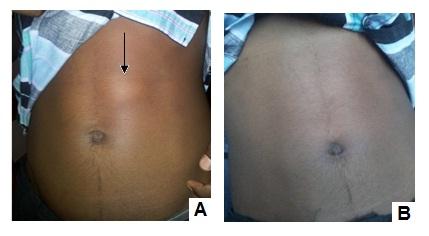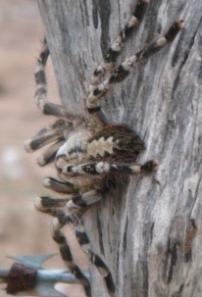Effect of built environment on tsunami related injuries
Dinamithra NP et al AMJ 2013, 7 (1)Open Access
Case Report
Clinical presentation and outcome of Sri-Lankan Ornamental
Tarantula Poecilotheria fasciata spider bite: a case report
Dinamithra NP1*, Sivansuthan S1, Johnson P1,Nishshanka JGP1 1 Teaching Hospital Jaffna, Jaffna, Sri Lanka Abstract
We report on a 19-year-old boy with visible muscle spasms admitted to the hospitals 24 hours after spider bite. He was treated effectively with intravenous calcium gluconate followed by oral calcium supplements and made a full recovery 48 hours after the incident. Although no specific treatment exists in Srilanka, it has been suggested that calcium supplements may be beneficial to relieve the muscle spasms. Our patient made a full recovery with calcium supplements suggesting the treatment with calcium is beneficial in relieving the pain and muscle spasms caused by Sri-Lankan Ornamental Tarantula Poecilotheria fasciata. Key words: Sri Lankan Ornamental Tarantula; Poecilotheria fasciata; Venom
Copyright: 2013 Dinamithra NP et al. This is an open access article distributed under the
which permits unrestricted use, distribution, and reproduction in any medium, provided the original work is properly cited. [email protected]
How to cite: Dinamithra N.P, Sivansuthan S, Johnson P,Nishshanka J.G.P. Clinical presentation and outcome of Sri-
Lankan Ornamental Tarantula Poecilotheria fasciata spider bite: a case report. Anuradhapura Medical Journal
Anuradhapura Medical Journal 2013 Volume 07 Issue 01 Page 10


Dinamithra NP et al AMJ 2013, 7 (1)
Open Access
Introduction
Throughout history, envenoming by animal toxins has
fascinated humans. Animal toxins have made a vast
contribution to enhancing knowledge in human
physiology and pharmacology. Information on the nature
and mechanism of action of these toxins has enabled a
more scientific approach to the treatment of their
intoxications. Early and specific treatment is frequently
required after envenoming and often includes life support
and maintenance of vital functions by mechanical
ventilation, intra venous fluid and drug therapy. Spider
Figure 1 A. Visible muscle spasms (indicated by arrow),
bites are associated with a mortality of 1-17% in Chile,
B. Disappearance of muscle spasms one hour after
Brazil(1), the Mediterranean region, Israel, North Africa
intravenous calcium gluconate therapy
and some regions in the former Soviet Union. Most spiders have neuroactive substances in their venom(2),
other systemic symptoms. He had taken 2 tablets (1 gram)
which are characterized by different affinities by a series
of paracetamol orally to relieve the pain.
of different receptors and ionic neuronal channels(3).
Twenty four hours after the incident he developed painful
During the predation, spiders inject neurotoxins which are
muscle spasms over right upper arm which made him to
able to cause paralysis of their prey due to the blocking
get admitted to the hospital. On admission he was in pain
actions at the neuromuscular junctions and/or at the
with visible muscle spasms over right tricep region, his
central nervous system (CNS); generally the voltage-
pulse rate was 40 beats / minute, respiratory rate 18 cycles
gated sodium (Nav) and voltage-gated calcium (Cav)
/ minute, and blood pressure was 120/80 mmHg. He was
channels constitute the most common targets of these
treated with 1 gram of paracetamol and 4 miligram of
toxins(3,4). Spider bites are mostly accidental and usually
Chlopheniramine oraly . His symptoms were subsided
they do not attack animals larger than themselves, some
after 4hours of the onset (28 hours the bite).
have aggressive behavior and will attack when
After 4 hours (28 hours the bite) he again complained of
approached by larger animals. Most spider bites on
severe abdominal pain mainly over epigastric region
humans are unintentional and happen when they press up
where visible muscle spasms was obvious. (Figure 2
against spiders and receive a defensive bite. We report on
A).Then he was treated with slow bolus of intravenous
a 19-year-old boy with visible muscle spasms admitted to
10% calcium gluconate 10 milliliter over 10 minutes. He
the hospitals 24 hours after spider bite.
made a good recovery after 1hour followed by a few short
lasting episodes of right triceps, right calf and rectus
abdominis muscle spasms which were not as severe as the previous.
On physical examination all the systems were normal
except bradycardia of 40/minute revealed as a sinus
bradycardia on 12 lead ECG. Blood investigations
Alanine Transaminase(ALT)- 20, Asparate Transaminase
(AST)- 29,WhiteBlood Count (WBC)-7000,Haemoblobin
(Hb)-13gram/deciliter,
(MCV) -86 Femto liter, Platelets -328,000/micro liter,
Blood Urea 22milligram/deciliter, Serum Na-144, K-4.7,
9.10milligram/deciliter (8.10-10.40) with normal Urine
Figure 2 Offending spider Sri-Lankan
Ornamental Tarantula Poecilotheria fasciata
After treatment (at 28 hours after the bite ) with single
dose of intravenous Calcium gluconate and oral calcium
Case presentation
lactate 300 milligram thrice daily , the patient improved
A 19-year old boy from Karainagar (9° 44' 53.07"N 79°
rapidly (Figure 2 B)and was discharged from hospital
52' 58.38"E) in Jaffna District admitted with right upper
after 24 hours of admission (48 hours of the bite ) with
arm pain and spasms of tricep muscle after 24 hours of a
calcium lactate 300mg thrice daily for three days.
spider bite to right foot. He was bitten by the spider at
about 4 p.m.at home garden while he was trying to take a
Discussion
photograph of the spider. Offending spider was identified
The clinical presentation and treatment modalities of
by the experts with the help of the photographs brought
Poecilotheria fasciata bite is not well documented in
by the patient (Figure 1)(5,6). Just after the bite he noticed
medical literature and there is no specific treatment for
a severe pain at the site with local swelling without any
Anuradhapura Medical Journal 2013 Volume 07 Issue 01 Page 11
Dinamithra NP et al AMJ 2013, 7 (1)
Open Access
that. Antivenoms are available for Latrodectus, Atrax and
Signs and symptoms occurring within hours to 36 hours
Loxosceles bites in many countries. These species are not
post envenomation are typically abdominal pain, nausea,
reported in Srilanka. Exact mechanisms of muscle spasms
vomiting, fever, often > 39 to 40°C, myalgia and
after Poecilotheria fasciata spider bite is yet to be
artheralgias, headaches, fatigue, and weakness.Most
identified. Pain and muscle spasms caused by spider bites
spider bites are harmless, and require no specific
are refractory to standard treatments but are relieved by
treatment. Treatment of bites may depend on the type of
intra venous calcium(7). Effectiveness of calcium
spider; thus, capture of the spider—either alive, or in a
gluconate is challenged in some studies[8]. Although
well-preserved condition, is useful.
calcium gluconate has been considered the first-line
Treatment for non-poisonous spider bites include washing
treatment of spider bite it is ineffective for pain relief
the bite with soap and water and ice to reduce
compared with a combination of intravenous opiods and
inflammation (10). Analgesics and antihistamines may be
benzodiazepines(8). Tarantula toxins inhibit activation of
used, however antibiotics are not recommended unless
voltage-activated potassium (Kv) channels by interacting
there is also a bacterial infection present (10) There have
with their voltage-sensing domains.They might cause the
been reports of significant bites by Poecilotheria species,
disturbance of skeletal muscle excitability responsible for
occasionally resulting in hospitalization. Symptoms
the tonic muscle spasms that have been described.
include localized pain and swelling, exhaustion, moderate
Possibly most relevant to our case of Poecilotheria
to severe muscle cramping, labored breathing and fever,
fasciata bite. It is postulated that the tonic spasms were
sometimes delayed days after the initial bite.
the result of a direct effect of venom neurotoxins acting
on voltage-gated sodium and/or calcium channels in the
Conclusion
victim's muscles(9). Our patient had a total plasma Ca2+
Although no specific treatment exists in Srilanka, it has
concentration of 9.10milligram/deciliter (8.10-10.40)
been suggested that calcium supplements may be
after intravenous Calcium Gluconate which was towards
beneficial to relieve the muscle spasms. Our patient made
the lower end of the normal range, hinting that Ca2+
a full recovery with calcium supplements suggesting the
might have entered the muscle fibres under the influence
treatment with calcium is beneficial in relieving the pain
of the putative spasm-producing toxin.Our patient had a
and muscle spasms caused by Sri-Lankan Ornamental
heart rate of around 40 beats per minute all throughout his
Tarantula (Poecilotheria fasciata).
hospital stay as well as two weeks review which we
However, there is little documented clinical evidence of
attributed to his normal heart rate.
the effects of this (Poecilotheria fasciata ) spider bite in
The clinical presentation depends on many variables,
humans, so firm conclusions about the level of danger
including the amount of venom injected. There is usually
posed by this spider cannot be drawn.
only one bite, which may cause cutaneous or systemic
manifestation or both. Other organs may be involved,
including the gastrointestinal system. The pancreas, renal,
pulmonary, and cardiovascular systems are less
commonly affected (10, 11).
Competing Interests
None
References
Lucas S. Spider in Brazil. Toxicon 1988; 26: 759-72.
Hagiwara K, Sakai T, Miwa A, Kawai N, Nakajima T, Agelenin. A new neurotoxin from the venom of the spider.
Symposium on Peptide Chemistry 1991; 1: 351–56.
Glenn F, King GG. Modulation of insect CaV channels by peptidic spider toxins. Toxicon 2007; 49: 513–30.
King GF, Escoubas P, Nicholson GM. Peptide toxins that selectively target insect NaV and CaV channels. Channels
2008; 2: 100–16.
Ratnatilaka A. Medically Important Ants, Bees, Wasps and Spiders. Author Publication 2011; 1: 112-15.
Samarawickrama VAMPK, Janananda MDBG, Ranawana KB, Smith A. Study of the distribution of the genus
Poecilotheria of the family Theraposidae in Sri Lanka. Ceylon Journal of Science 2005; 34: 75–86.
Key GF. A comparison of calcium gluconate and methocarbamol in the treatment of Latrodectism. The American
journal of tropical medicine and hygiene 1981; 30: 273-77.
Clark RF, Wethern-Kestner S, Vance MV, Gerkin R. Clinical presentation and treatment of black widow spider
envenomation: a review of 163 cases. Annals of emergency medicine 1992; 21: 782-87.
Swartz KJ. Tarantula toxins interacting with voltage sensors in potassium channels. Toxicon 2007; 49: 213-30.
10. Hematology Basic Principles and Practice. 4th ed. Philadelphia: Churchill Livingtone
2005; 712–716.
Anuradhapura Medical Journal 2013 Volume 07 Issue 01 Page 12

Dinamithra NP et al AMJ 2013, 7 (1)
Open Access
Submit your next Manuscript to
Medical Journal
Submit your manuscript at
Anuradhapura Medical Journal 2013 Volume 07 Issue 01 Page 12
Source: http://amj.sljol.info/articles/10.4038/amj.v7i1.6136/galley/4799/download/
Ch02_p 45.78
Modern Organocopper Chemistry. Edited by Norbert Krause Copyright > 2002 Wiley-VCH Verlag GmbH ISBNs: 3-527-29773-1 (Hardcover); 3-527-60008-6 (Electronic) 2Transmetalation Reactions Producing Organocopper Reagents Paul Knochel and Bodo Betzemeier Organocopper reagents constitute a key class of organometallic reagents, with nu-merous applications in organic synthesis [1]. Their high reactivities and chemo-selectivities have made them unique intermediates. Most reports use organocopperreagents of type 1 or 2, which are prepared from organolithiums. This trans-metalation procedure confers optimal reactivity, but in many cases it permitsonly the preparation of relatively unfunctionalized organocopper reagents. Morerecently, substantial developments have been taking place in transmetalations toorganocopper reagents starting from organometallic species that tolerate the pres-ence of functional groups [2], while synthetic methods permitting the preparationof functionalized organolithiums and organomagnesium compounds have alsobeen developed. All organometallics in which the metal M is less electronegativethan copper, and all organometallic species of similar electronegativity but withweaker carbon-metal bonds, are potential candidates for transmetalation reac-tions [3]. Thus, reaction conditions allowing the transmetalation of organo-boron,-aluminium, -zinc, -tin, -lead, -tellurium, -titanium, -manganese, -zirconium and-samarium compounds have all been found, resulting in a variety of new organo-copper reagents of type 3. Their reactivity is dependent on the nature of the origi-nal metal M, which in many cases is still intimately associated with the resultingorganocopper reagent (Scheme 2.1) [3–5].
rotherhamhospice.org.uk
Metabolic or drug induced: Haloperidol ORAL THRUSH: 500micrograms to 5mg oral nocte, ( ), OR: Good oral hygiene, and: Miconazole oral gel 24mg/ml Levomepromazine, oral or sc, from 6.25 mg od. qds treatment should be continued for 48hours after lesions have healed. Fluconazole 50mg daily Intestinal obstruction - contact Specialist Palliative